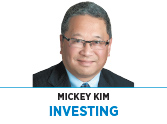Subscriber Benefit
As a subscriber you can listen to articles at work, in the car, or while you work out. Subscribe Now There is no doubt that U.S. stocks and the economy are on a tear. Stocks are at record highs, fueled by higher corporate earnings, which are surging based on strong economic growth and lower tax rates. The unemployment rate continues to fall and, with the economy essentially at full employment, wages are starting to rise. Higher stocks and wages have propelled consumer confidence to an 18-year high, bolstering spending and corporate profits.
There is no doubt that U.S. stocks and the economy are on a tear. Stocks are at record highs, fueled by higher corporate earnings, which are surging based on strong economic growth and lower tax rates. The unemployment rate continues to fall and, with the economy essentially at full employment, wages are starting to rise. Higher stocks and wages have propelled consumer confidence to an 18-year high, bolstering spending and corporate profits.
With this virtuous circle/positive feedback loop in full swing, it sure seems as though the future will continue to be bright for U.S. stocks and the economy. While we don’t see anything near term to derail stocks (like a recession), the fact remains that both the stock market’s advance from the March 2009 lows and the economic expansion are long in the tooth.
Indeed, we are carefully monitoring signs that may be indicating Goldilocks (in the form of low interest rates, low inflation, low unemployment and low oil prices) has left the building. Valuations are reasonable and our outlook for the future remains positive, but this is no time to be complacent or overconfident.
Our mantra is that stock prices follow earnings, which were strong enough to swamp the historically reliable tendency of stocks to struggle during midterm election years. According to Strategas Research Partners, during midterm election years since 1962, stocks have been flat to down through the first three quarters of the year and experienced an average correction of 19 percent during the year. That obviously didn’t happen this year, but we’re hopeful the perfect record of the S&P 500 rising in the 12-months following the midterm election remains intact.
Low interest rates have been an important driver for higher stock prices. All other things being equal, lower rates justify a higher price-to-earnings ratio (and vice versa). Additionally, lower rates tend to make bonds less competitive compared with stocks. The yield on the 10-year U.S. Treasury bond has surged by more than 35 percent over the past year due to the strengthening economy, from 2.33 percent to a recent 3.16 percent (the highest level since July 2011). Higher bond yields equate to lower bond prices—a harsh reality bond fund investors will become familiar with when they open their Sept. 30 statements.
Since bottoming at $26.21 per barrel in February 2016, West Texas Intermediate crude oil prices have almost tripled to a recent $76.41 per barrel, the highest level since 2014. Strength in the global economy is leading to higher demand while supply from Iran (U.S. sanctions go into effect Nov. 4) and Venezuela (economic collapse) is falling. Oil is an important production input into many products, so higher oil prices will lead to higher overall prices and inflationary pressures. Consumers had grown accustomed to guzzling cheap gasoline, so higher prices at the pump are like an additional tax.
Higher stock prices and the robust employment picture have combined to send consumer confidence to an 18-year high. The Conference Board’s Consumer Confidence Index recently hit 138.4, up from 25.3 in February 2009 (at the bottom of the Great Recession) and the highest level since the 142.5 reached in September 2000. With consumer spending accounting for almost 70 percent of economic activity, surging confidence has clearly been great for the economy.
The downside is there is an inverse relationship between consumer confidence and future stock performance. Historically, when stocks are low, confidence is low and future returns tended to be higher and vice versa. According to Ned Davis Research, going back to 1969 when consumer confidence was below 66, stocks returned 14.8 percent on average over the following year. When the index was between 66 and 113, the average return dropped to 6.3 percent. When the index was above 113, the average return dropped even further, to 2 percent.
We think Howard Marks from Oaktree Capital Management is a bright guy and makes a lot of sense. He said, “The best response when seas are choppy is to focus on completing the long-term voyage and not think about whether the next wave is going to push the nose of the boat up or down. Our investment destination is best reached by accurately valuing assets, assessing the relationship between price and that value, and acting resolutely and unemotionally when mispricings are detected. That’s still the best—I think the only—reliable path to investment success. Nothing about the current environment alters that one bit.”
We couldn’t agree more. •
__________
The column was excerpted from Kirr Marbach & Co.’s third quarter client letter, available at www.kirrmar.com. Kim is the chief operating officer and chief compliance officer for Kirr Marbach & Co. LLC. He can be reached at 812-376-9444 or mickey@kirrmar.com.
Please enable JavaScript to view this content.
